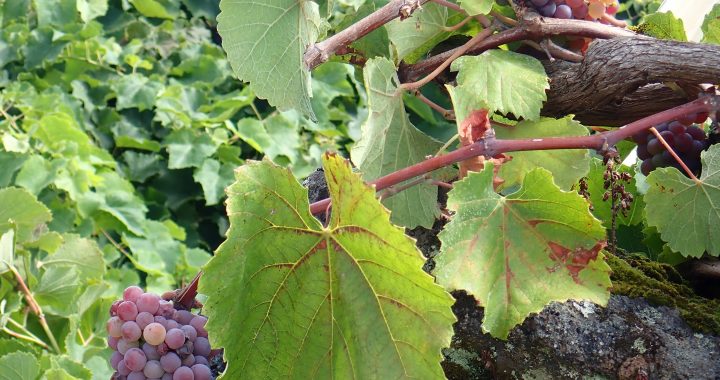Cruising in the Azores archipelago just seems to get better with each passing day. Every island is unique and yet they share so many basic traits that make exploring these islands a delight. The common threads are the people – who I found to be genuinely warm and welcoming throughout the islands; excellent infrastructure that makes them easy and comfortable to explore on foot, by bus, scooter or by car; excellent food variety, both local and imported; and a community that enjoys the outdoors and an active lifestyle. The islands all have exercise parks, well-marked trail systems, natural pools along the coasts and warm clean waters to swim in. Culturally, each island has a history that they have preserved and present in museums, information plaques and historical sites. There are frequent festivals, sporting and cultural events throughout the islands where visitors are welcome and encouraged to participate. Add to all of the above the natural wonders that abound on every island, or in the warm waters surrounding them and it is very easy to fill each day with new adventures.
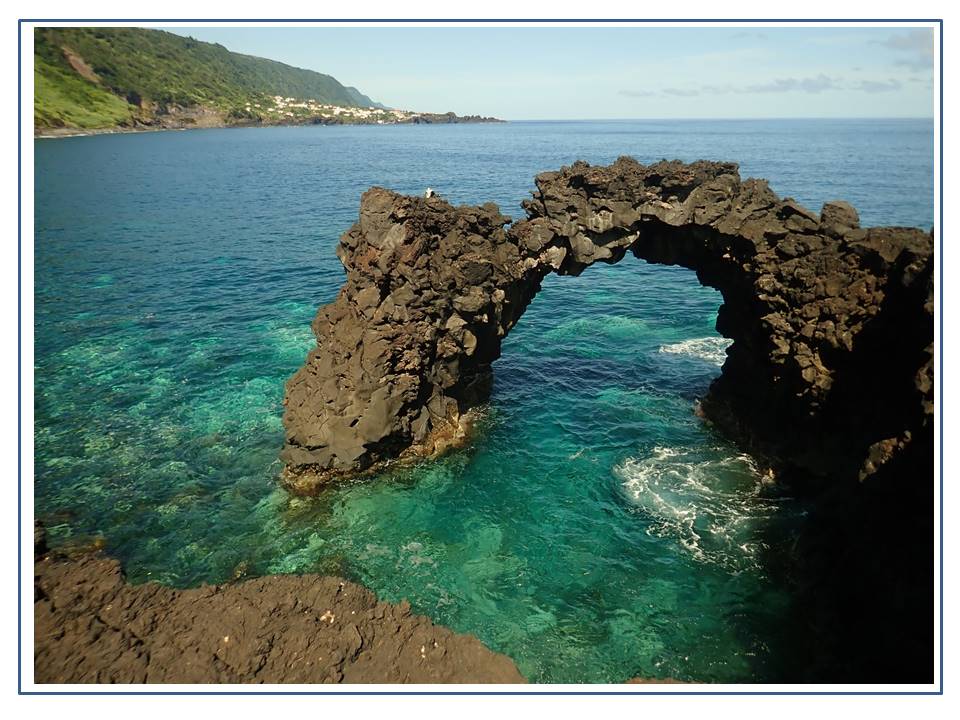
Caption: One of many natural arches along the northern coast of São Jorge Island and the warm crystal clear waters of the Azores.
For us sailing on Oh! our 40 foot catamaran, Pico, São Jorge and Graciosa were a tale of three anchorages. The Azores are young geologically and shield volcanic islands are not typically blessed with an abundance of natural harbours. Therefore, good anchorages are limited and even then they are usually exposed to weather in at least one or two directions. The larger bays or leeward areas that offer some protection are typically enlarged with massive breakwaters or “moles”. This has been done in order to enhance and expand the limited protection the few natural bays have. The Azores have put a lot of effort into creating man made harbours or enhancing the limited natural harbours. By building poured concrete, concrete block, rock and tetrahedron-faced walls, they have greatly enhanced the limited protection offered by the natural harbours. The result is good marinas for local fishing and pleasure craft, as well as more options for visiting yachts. However, it still becomes a planning task of ensuring that the harbour you are in, or want to visit has space and offers protection from whatever direction the forecasted winds and waves may be coming from. During the height of the season this can be difficult as the larger marinas are quickly filled by visiting yachts and the smaller ones often have very limited transient space available. Plus, anchoring may not be allowed in all areas or within the areas protected by moles. Therefore, for extended cruising in the Azores it becomes a game of shuffling around the few available anchorages to match the changing weather, or getting dock space reserved well in advance. The islands of Pico, São Jorge and Graciosa work very well as a group since they are close together and their limited number of anchorages each offer good protection from different directions. We spent 2 weeks exploring and enjoying these islands moving among them to find shelter as weather patterns changed.

Caption: The Azores Archipelago. The semi-dormant 2351m summit of Mt. Pico dominates the skyline of Pico Island. Madalena harbour on Pico Island viewed from Oh! was one of our favorite Azores anchorages.
Madalena is the main harbour on Pico and has a beautiful, although small, anchorage inside the massive moles with room for half a dozen boats over a good sand bottom. The harbour has a lot of commercial traffic with shipping and ferries, but the small corner in which you can anchor remains quaint and picturesque. The waters are clear and warm for swimming, or you can enjoy the natural pools and sunbathing areas that have been created along the jagged volcanic rock shore line. The town’s main square, church and the towering summit of Mt. Pico created a wonderful backdrop each morning as we enjoyed breakfast on Oh!’s spacious aft deck.
Pico has been known for its excellent wines for centuries. At one time its wines were highly sought after by heads of European states and even as far away as Russia. Unfortunately, blight decimated much of the wine industry and Pico is now in the process of resurrecting its heritage of wine making. Together with our Norwegian friends, we decided to have a scooter tour of the island. The route took us past many abandoned vineyards along the east side of the island. They were easily recognized by their prominent dry pack lava stone walls that created hundreds of small square plots in which maybe 2-6 vines would be planted. It was a sad to see so much labour invested in creating miles of rock walls, all created by hand, one stone at a time, that are no longer productive. The walls were necessary to help to retain heat and moisture, as well as protect the vines from the winter storms.
As we toured the island we found many operating vineyards along the North and Northwest coasts and saw several extended families and groups of friends working in the fall sunshine harvesting barrel loads of deep red grapes. Wherever we stopped, we found the workers were happy to give us samples of the delicious grapes. It almost seemed sad to see them being crushed for their juice! The harvest was being conducted as it has probably been done for hundreds of years. Extended families and friends gather to hand cut the grapes and haul them in buckets made from ½ of a wine barrel or large plastic tubs to a waiting flatbed or pickup truck. It could just as easily have been a horse or donkey pulled cart. Then they were crushed and pressed with the same screw style presses we had seen in the museums. It is not uncommon for family members that had left to live in North America between 1950-1960, to return each year to help with the grape harvesting and to maintain their attachments to family and the Azores.
As we rode around we saw ruins of the round rock bases that marked the many windmills that were once used on the island. Several of the windmills have been restored and are open to visit. The internal gearing and mechanics of the mills were fascinating and the beautifully built wooden gears were like works of art. Our Norwegian friends told us that the word “Saboteur” was coined in Dutch from people jamming wooden shoes (a “Sabot” or shoe, in Dutch) into the wooden windmill gears to destroy them. I am not sure if it is true, but if so, it is a great example of how languages evolve!
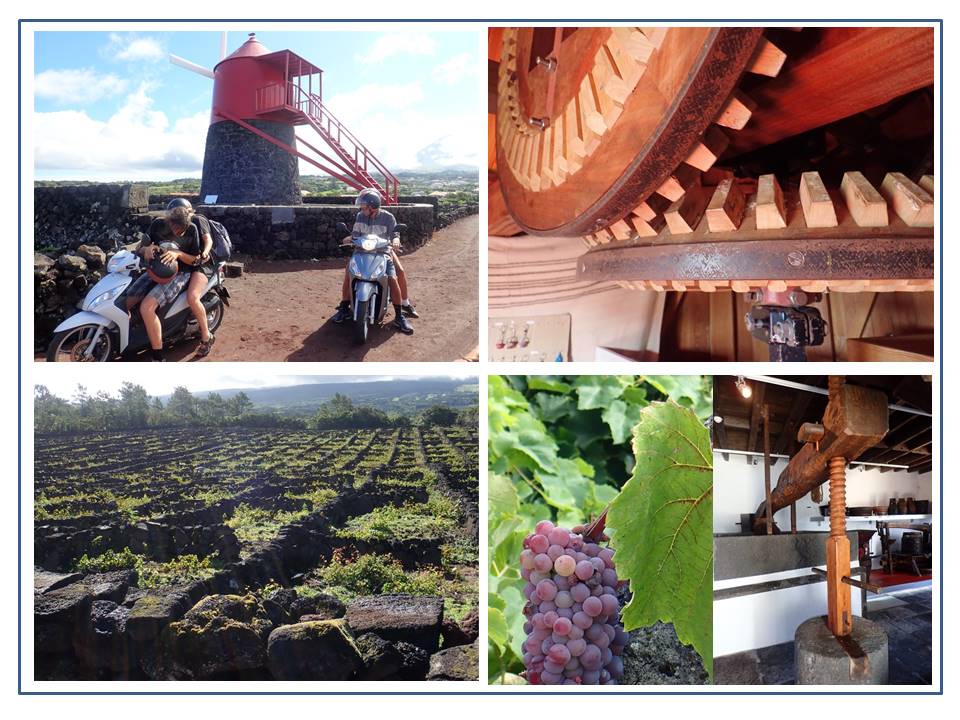
Caption: A restored windmill located on one of Pico’s many grape growing areas. Traditional equipment like this press is still used by some of the smaller family run growers. There are hundreds of miles of small plots surrounded by 4-6 foot high dry pack rock walls that protect the vines from the North Atlantic storms.
For much of the past two centuries whaling was a big industry in the Azores and there were dozens of mostly abandoned whale processing plants scattered around all the islands. Many of the smaller plants are now simply ruins, larger ones have become museums to what was an important contributor to the economy and the livelihood of so many Azoreans. The smell of the whale carcasses being butchered and the blubber processed for oil extraction was apparently pretty strong. I spoke with several people who remembered the “welcome odour” from the processing plants, as it was the smell of good fortune for everyone. The benefits of whaling were felt throughout the community, not just by those directly involved in the catch and processing of the whales. All levels of the community from grocers to bankers knew the importance of whaling in the Azores. At one point all the street lamps in London were fueled with whale oil from the Azores. That one note really made an impact as I contemplated the number of whales that would have required, and London wasn’t the only city with street lamps at that time. The whale oil was not the only product though – every part of the whale was used in some form. The whaling era eventually ended in the late 1960’s as whale populations declined and international pressure mounted to end the practice of whaling. Today the industry has evolved to whale watching and museums proudly keeping the history of whaling in the Azores alive through multimedia presentations and displays. One of the very best museums we saw was in Lajes do Pico, on the western end of Pico Island. The museum had the best displays of Azorean whaling equipment, tools, products that were made from the whales, multimedia presentations and information of any museum we saw in the Azores.
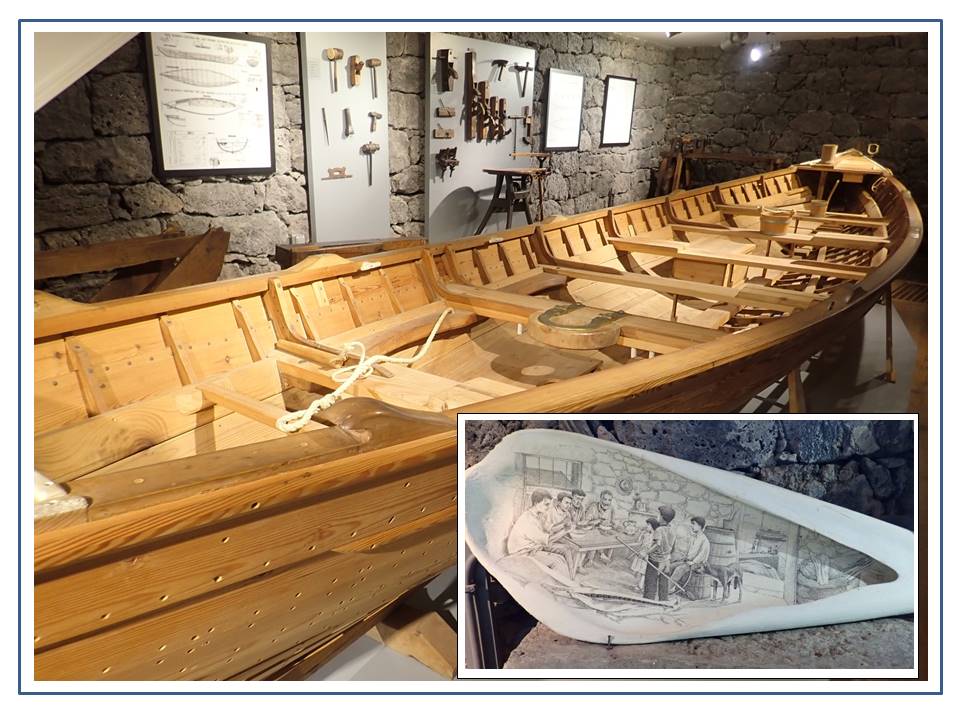
Caption: A beautiful replica of an Azorean Whaling boat under construction at The Whaling Museum in Lajes Do Pico. Insert, scrimshaw on the inside of a whale bone that is well over 1m long.
Pico’s biggest attraction is the towering summit of Mt. Pico at 2351m high. Unlike the shield volcanoes that created the rest of the Azores Islands, Mt. Pico has not “blown its top” to become a large caldera. As a result it is a completely intact massive cone that creates a very distinctive profile. Today this sleeping giant is ringed with seismic monitoring stations to hopefully give advance warning if the volcano re-awakens to become active. As a geologist, it was impressive to look at Mt. Pico from São Jorge and compare the massive volume of Mt. Pico – to what would have been above the calderas on the surrounding islands such as Horta. The power that must be unleashed to literally blow a third or more of Mt. Pico up into the sky and then down its steep slopes is almost incomprehensible – yet it happens. We saw the aftermath of the power of those types of volcanic eruptions in St. Pierre on Martinique, and again at Monserrat of just how devastating these eruptions can be. History has many examples of the awesome power of volcanoes the most famous of which is Pompeii in Italy. For now, Mt. Pico is taking a rest and offers energetic hikers an opportunity to enjoy a great day hiking to the highest point in Portugal.
The hike up the summit is regulated to no more than 200 people on the mountain at any given time. If you want to book a time to do the hike it must be with a guided tour. If you are the fiercely independent type like David and I, and you want to go up without a guide, you need to show up at the mountain base, get a number – then wait patiently until your time comes up to replace someone who has just arrived back down. So an early morning arrival at 8 am to get a number found us 33rd in line and eventually an 11:30am start time for the climb. No problem, we enjoyed chatting with a number of people from all over the world who were all eagerly waiting for their names to be called as well.
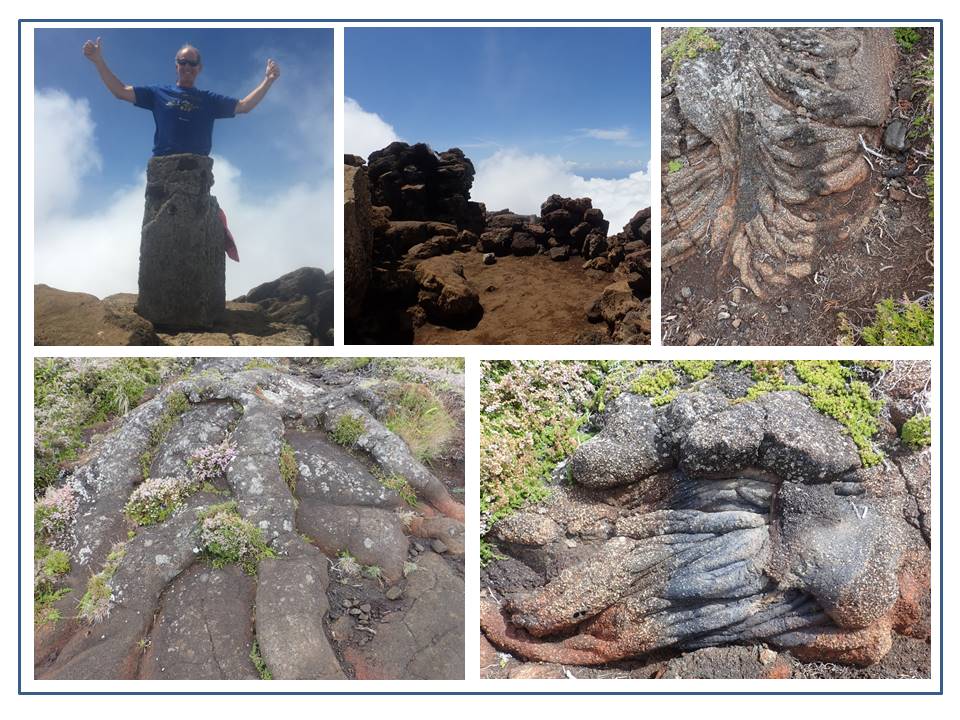
Caption: Standing on top of Mt. Pico was the second major summit of the Atlantic circuit. View from the top “above the clouds” but warmed by the fumeroles, a welcome surprise at 2351 m! The “Art of Nature” lava flows in an infinite variety of forms like sculptures with variable colors and textures. Shown are three of hundreds of rock forms that kept the steep trail interesting.
The climb up Pico was something that I had not really had on my bucket list, but it was a big one for David (From the Catamaran Adventurous that I informally raced across the Atlantic with). David is packed with energy and is determined to live life to the fullest every day and I enjoyed is infectious enthusiasm for knocking off the items on his long bucket list. The trail starts in small scrub trees and quickly climbs through lava flows from long ago and past exposed lava tubes. The views are spectacular right from your first steps out of the Interpretation Center and Park office. Once past the tree line you enjoy incredible 180 degree panoramas with each foot step. Along the way the “Art of Nature” is displayed in the various types of Lava flows, colouring of the weathered lava; and the artistic geometry the molten lava would form as it cooled and stopped flowing. There is everything from the tuffs and bombs of lava that have been blown out of the top of the active volcano, to beautiful sinewy flowing patterns formed from lava as it flowed and cooled on its way down the mountain. At the top, Mt. Pico is truly a peak that ends in a point about 10 square meters in size. You truly are on “the peak” of Mt. Pico. The biggest surprise was to arrive at the top expecting to be in cool high altitude air only to be greeted by the warm moist air of the fumeroles, or steam vents. Mona and Arno had climbed Mt. Pico overnight to catch the sunrise. After a cold night on the mountain just below the summit, they were surprised and especially happy to be warmed at the summit by a steam bath as they waited for the first warming rays of the sun.
Our leisurely hike up and back took almost the same time up and down- just under three hours each way to traverse the 1051 meters of elevation change from the Interpretation Center to the peak. It is steep though, with an average grade of 25% and steepest grades over 40% near the summit. One of the most satisfying moments came the next morning as I looked up at Mt. Pico while enjoying breakfast in the anchorage recalling so many great memories of the hike. I now had a much more personal attachment to the beautiful setting surrounding Madalena harbour.
When the winds shift around to the Northeast, it is time to leave Madalena and Pico island for better protection offered at Vila das Velas on São Jorge Island. You can anchor there outside the small well protected marina, but still be within the protection of the outer mole. The anchorage is comfortable for about 6-10 yachts and is in a spectacular setting with steep cliffs where Cory’s Shearwater birds nest. In the evening the sound of their distinctive calls fill the air as they swoop and dive along the cliffs.The town of Velas is beautiful with large mosaic tiled pedestrian areas, café’s, waterfront promenade, natural pools and well preserved architecture. Velas is a wonderful place to enjoy views of the sunsets behind the towering summit of Mt. Pico just 15 miles away. The marina allows anchored yachts to use its dinghy dock, showers, laundry and restrooms for a small fee. As with all of the islands in the Azores, you must check in when you arrive and the officials are always welcoming and happy to talk about their island.
It was in Velas that we discovered the portable wireless router that works off the cellular network, with inexpensive data plans that are available throughout the Azores and Portugal. It was fantastic to finally have reliable, high speed secure internet. The portable routers meant we could take them with us everywhere and even had connectivity up to 15 miles offshore as we approached or departed islands. This same inexpensive and reliable internet service was also available on our portable routers in the Madiera and Canary Islands. One of the biggest frustratons I have had throughout the Caribbean was the difficulty in obtaining good secure internet service since each island is a different country and has different service providers. In the Azores it was one of our fondest wishes come true and it made cruising and exploring the islands so much easier and enjoyable!
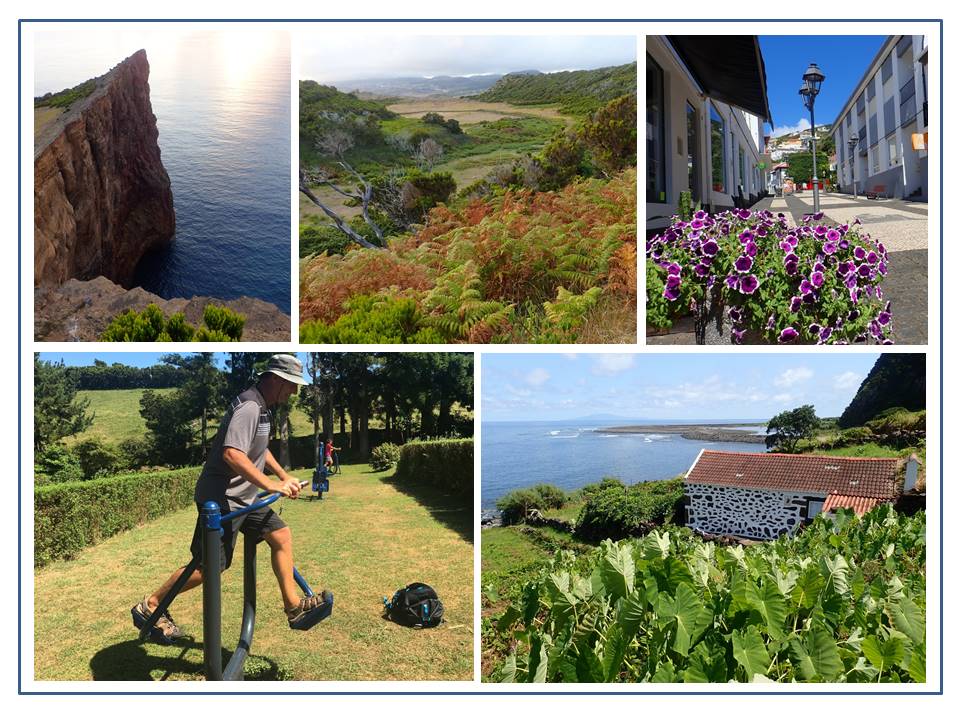
Caption: Spectacular views from the steep cliffs of the caldera near Vila das Velas, on São Jorge Island. Mosaic stone pedestrian malls in the town of Velas. Faja Da Caldeira De Santo Cristo is located at the base of steep cliffs along the northeast side of São Jorge Island. Throughout the Azores we found exercise parks or exercise trails like this one on São Jorge at Sete Fontes Forest Reserve.
São Jorge is a long relatively narrow island like Pico – but not like Pico. Where Pico is a much younger and rugged dry volcanic island; São Jorge is more mature, filled with pastures and open agricultural lands along its upper plateaus. These plateaus were once covered in thick stands of trees that were logged and eventually turned into large rolling pastures. Several areas that are still covered in stands of native forest are now natural parks like the Recreational Forest Reserve of Sete Fontes. They are a stark contrast to the wide open spaces that now cover most of the island. São Jorge is highly regarded for its cheeses and agricultural products that come from these beautiful pastures.
There are also many beautiful hikes and small villages to visit. The northern side of the island is dominated by tall steep cliffs with a few flat areas along the coast that were created over time by landslides. These flat areas and are called fajas. A faja is Portuguese for any flat area that you can build on. Usually they are areas where landslides have created a flat area along a coast at the base of steep cliffs. The roads down to these villages are impressive engineering works that wind down the steep slopes and cliffs and are fun to ride on scooters. At the bottom you will usually find a small village with a restaurant or café and one of the many trail heads for the island’s well defined trail network. There are many beautiful hikes that originate on the plateau 400m above sea level and end at the Fajas. One of the most spectacular and popular hikes is to Caldeira De Santo Cristo where the small village is tucked below towering cliffs on a former landslide that created a lagoon and beautiful Faja. It is also well known for surfing.
The central part of the island is a high plateau of open rolling fields and rounded hilltops which allow you to enjoy fabulous vistas of Pico Island just 15 miles to the west, or open views of the length of São Jorge. We visited São Jorge several times while in the Azores, taking advantage of its snug harbour to explore the island.
When the weather shifted again to light winds from the west we had a short weather window to visit Graciosa Island. The marina at Vila da Praia is well protected by two large moles, however it is almost full with local boats and only has room for a few monohulls of modest size, and maybe one small catamaran – but only if there are no other visiting yachts. So Oh! was restricted to using the bay outside the marina that is open to the south and east with only limited protection from the mole. That was fine for us as the weather was forecast to be settled for at least 2 days. That gave us time for a quick two day exploration – and what an adventure it was.

Caption: The cave in the volcanic core at the Furna do Enxofre on Graciosa Island. Grapes in the vat ready to be crushed, by foot of course, Sampling last year’s vintage. Monitors showing the concentration of CO2 and air temperatures at various levels in the Furna do Enxofre cave.
Graciosa is a small island and although there is a lot to do and see, a single day’s guided tour will certainly cover the highlights. The only problem with that is it just wets your appetite to spend a lot more time exploring the island. In a single day we visited the thermal spas, toured the west coast, stopped and explored the Furna do Enxofre cave and underground lake, had a wonderful lunch break exploring the town of Santa Cruz, had an impromptu wine tour and tasting and ended the day with a cruisers dinner on Oh!. Each of these could easily have been made into at least a half day’s outing if we had the weather window to remain at anchor in the harbour, or were fortunate enough to have found room in the marina. As with all of the Azores Islands we had visited, there were excellent museums to visit, plenty of public artworks, and residents that were very proud of their culture and their islands history. Everyone we met was friendly and more than willing to talk about life on Graciosa Island.
Two of the many highlights of our taxi tour were events that were totally unplanned and which just came together as the day unfolded. The first part occurred when we stopped in Santa Cruz for lunch with time to explore the town that led to a chance discovery and viewing of a museum dedicated to the Graciosa agriculture and wine making industries. The displays were excellent with beautifully restored and working condition examples of the implements Azoreans had traditionally used for hundreds of years. The implements were used in creating arable land, tilling the fields, harvesting a variety of crops and for processing grapes into highly sought after wines. There were multimedia and graphic depictions of how life on the island evolved through the centuries of Portuguese settlement and the importance of agriculture to the economic growth of the island. As we found in all the islands, the museums were very inexpensive so there was never any hesitation to enter them and they are so well done that you looked forward to finding the next one.
The second part of the afternoon’s chance encounters occurred as we were leaving Santa Cruz. We passed a group of men unloading a pickup truck full of overflowing half barrels of deep red grapes. We asked our taxi guide if we could make a brief stop so we could get some pictures which he happily agreed to. That quickly led to an impromptu tour of the owner’s small family wine making business. It was housed behind a large door to a small single garage sized room packed with all the required equipment to make wine. We were welcomed with broad smiles as our taxi guide played interpreter for our many questions. Without prompting the owner proudly offered several handfuls of the freshly picked grapes for us to taste from the barrels that were ready to be crushed. Then out of nowhere a picnic table appeared complete with glasses and a jug sized bottle of last year’s vintage. That quickly led to an impromptu “wine break” for his friends that were helping him with the harvest and a sampling session for us. There were smiling faces and happy people all around as we enjoyed the owners wines and learned about winemaking on Graciosa. His garage size winery was a working set of the same artifacts we had just seen in the museum. From this year’s harvest the owner expected to make about 11,000 liters of wine which would almost entirely be consumed by friends and family. The entire experience was fabulous and left us with wonderful memories and a strong desire to return and spend more time on Graciosa.
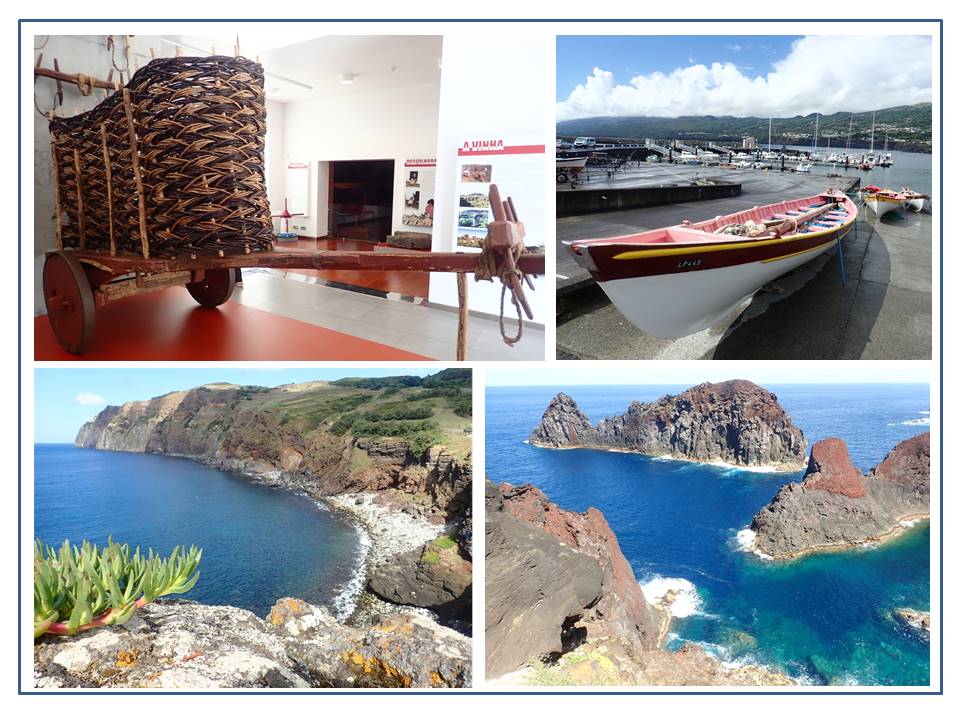
Caption: A restored traditional ox cart in the Agricultural Museum on Graciosa Island. Each Island has teams that compete in rowing and sailing races with traditional whaling boats, these are on Pico Island at Lajes Do Pico. Whale rock on Graciosa Island and the beautiful clear waters of the Azores. The rugged west coast of Graciosa Island with its steep cliffs and flat fields above.
Unfortunately, the calm weather we needed to safely remain in the harbor anchored at Vila da Praia was forecast to change, so despite our desire to stay longer, we needed to move to a more sheltered anchorage. We would make one more stop in Velas on São Jorge Island before heading east to the Island of Terceira. If I could have only one wish in the Azores, it would be to have more time on each island. However, as fall approaches the weather becomes less stable and that means moving among the islands to find suitable anchorages in ever shorter time frames. Plus, our Schengen clock was ticking, and we still had 3 more islands to visit before the onset of late fall weather and possibly gales. After a very tasty bite sized sampling of Graciosa Island, we left with great memories of a jam packed visit. I am looking forward to returning one day and spending more time exploring Graciosa.
To be continued in “Postcards from an Atlantic Circuit Part 7 – An Azores Summer”.
References from: Atlantic Islands Sixth Edition – RCC Pilotage Foundation, Imray books. Authors Anne Hammick and Hilary Keatinge
About the author: Rod Morris
SV Oh! 2006 Robertson and Caine Leopard 40’ Catamaran
Website: www.cloudstocoral.com
Biography
Rod has been sailing Oh! throughout the eastern Caribbean for the past three seasons offering people the chance to ”Sample the Cruising Lifestyle” and is currently completing an Atlantic Circuit. He has enjoyed 8 Caribbean passages and 3 Atlantic Passages (including 1 solo) over the past 10 years. You can follow the travels of Oh! on Instagram at: sv_oh , or find out how you can join Oh! through the website: www.cloudstocoral.com. Rod is a Professional Geologist, Glider Pilot and RYA Yacht Master (Offshore) and a member of the Blue Water Cruisers Association. He can be reached at info@cloudstocoral.com
